The Effects of Multi-Scenario Land Use Change on the Water Conservation in the Agro-Pastoral Ecotone of Northern China: A Case Study of Bashang Region, Zhangjiakou City
Abstract
:1. Introduction
2. Materials and Methods
2.1. Study Area
2.2. Data Sources
2.3. Land-Use Change Analysis and Multiscenarios Prediction
2.3.1. Geoinformation Tupu Model Analysis
2.3.2. Multi-Scenarios Setting
- NDS (natural development scenario): This scenario excludes the influence of anthropogenic and socio-environmental factors. It forecasts land-use changes for 2035, relying exclusively on the natural trends in land-use transformation observed between 1990 and 2020.
- APS (agricultural production scenario): In this scenario, the study region simulates the maximum extent of arable land expansion under an agricultural development objective. Specifically, the conversion of unused land, forest, and grassland into arable land is promoted while ensuring that existing arable land (both irrigated and rain-fed land) remains unchanged. Therefore, in the configuration of neighborhood weights, the transition probabilities for irrigated land and rain-fed land were increased by 30%. Prohibitions were imposed on the conversion of cultivated land to other types.
- EPS (ecological protection scenario): This scenario incorporates ecological conservation objectives for the study area. This study proposes, for this scenario, simulating the maximized expansion of ecological lands, particularly forest and grassland. The framework emphasizes the dual imperatives of protecting and enhancing ecological land resources. Under this configuration: (1) strict prohibitions were instituted against the conversion of forest and grassland to other types and the transformation of unutilized land to cultivated areas; (2) transition from rain-fed land to irrigated land was restricted; (3) neighborhood weights underwent strategic adjustments—irrigated land weights were decreased by 50%, rain-fed land weights were reduced by 20%, and grassland and woodland weights were increased by 40%.
- LPS (land planning scenario): according to the Zhangjiakou Capital Water Conservation Functional Area and Ecological Environment Support Area Construction Plan (2019–2035), the objectives for 2035 are set as follows: The Bashang region of Zhangjiakou will progressively transition irrigated land to alternative land uses while restoring abandoned land through grass planting. Additionally, as stipulated in the Land Use Master Plan for Four Counties in the Bashang Region of Zhangjiakou (2021–2035), the permanent basic farmland area in Zhangjiakou Bashang is designated as 4551.26 km2. Based on these planning targets, the LPS is defined as follows: (1) full conversion of irrigated land to rain-fed land while strictly prohibiting the transformation of other land categories into irrigated land; (2) reduce the transition probability of irrigated land by 50%, while increasing the transition probability of forestland and grassland by 20% and 40%, respectively; (3) ensure cultivated land area remains within the protection red line for basic farmland; (4) strictly prohibit the conversion of forestland and grassland to other types.
2.3.3. The FLUS Model
2.4. Water Conservation Assessment
2.4.1. The InVEST Water Yield Model
2.4.2. Calculation Method of Water Conservation
2.4.3. Validation of InVEST Model Accuracy
2.4.4. FLUS-INVEST Model Framework
3. Results
3.1. Geoinformation Tupu of LULC
3.2. Multi-Scenario LULC Simulation
3.3. Evaluation of Water Conservation Based on InVEST and Main Driver Analysis
3.4. Multi-Scenario Water Conservation Simulation
4. Discussion
4.1. Effects of LULC on Water Conservation Function
4.2. Impact of Different Scenarios on Water Conservation Function
4.3. Climate Impacts on Water Conservation Function
4.4. Limitations and Future Works
5. Conclusions
Author Contributions
Funding
Institutional Review Board Statement
Data Availability Statement
Acknowledgments
Conflicts of Interest
Abbreviations
| WY | Water Yield |
| WCC | Water Conservation Capacity |
| LULC | Land Use/Land Cover |
References
- He, C.; Liu, Z.; Wu, J.; Pan, X.; Fang, Z.; Li, J.; Bryan, B.A. Future global urban water scarcity and potential solutions. Nat. Commun. 2021, 12, 4667. [Google Scholar] [CrossRef] [PubMed]
- Boretti, A.; Rosa, L. Reassessing the projections of the World Water Development Report. npj Clean Water 2019, 2, 15. [Google Scholar] [CrossRef]
- Rosa, L.; Chiarelli, D.D.; Rulli, M.C.; Dell’Angelo, J.; D’Odorico, P. Global agricultural economic water scarcity. Sci. Adv. 2020, 6, eaaz6031. [Google Scholar] [CrossRef]
- Winkler, K.; Fuchs, R.; Rounsevell, M.; Herold, M. Global land use changes are four times greater than previously estimated. Nat. Commun. 2021, 12, 10. [Google Scholar] [CrossRef]
- Guo, Q.; Yu, C.; Xu, Z.; Yang, Y.; Wang, X. Impacts of climate and land-use changes on water yields: Similarities and differences among typical watersheds distributed throughout China. J. Hydrol. Reg. Stud. 2023, 45, 101294. [Google Scholar] [CrossRef]
- Liu, X.; Liu, Y.; Wang, Y.; Liu, Z. Evaluating potential impacts of land use changes on water supply–demand under multiple development scenarios in dryland region. J. Hydrol. 2022, 610, 127811. [Google Scholar] [CrossRef]
- Qiao, J.; He, J.; Li, Y.; Yang, X.; Peng, Y.; Wang, H.; Yu, F.; Wu, J.; Gong, S.; Che, H.; et al. Analysis of the spatiotemporal changes in global land cover from 2001 to 2020. Sci. Total Environ. 2023, 908, 168354. [Google Scholar] [CrossRef]
- Fernando, M.; Néstor, M.; Ximena, Q.; María, J.; Paúl, C. What Do We Know about Water Scarcity in Semi-Arid Zones? A Global Analysis and Research Trends. Water 2022, 14, 2685. [Google Scholar] [CrossRef]
- Yang, R.J.; Chen, H.; Chen, S.; Ye, Y.M. Spatiotemporal evolution and prediction of land use/land cover changes and ecosystem service variation in the Yellow River Basin, China. Ecol. Indic. 2022, 145, 109579. [Google Scholar] [CrossRef]
- Zhao, L.; Shen, Y.J.; Liu, M.; Wang, Y.; Li, Y.; Pei, H. The Impacts of Land Use Changes on Water Yield and Water Conservation Services in Zhangjiakou, Beijing’s Upstream Watershed, China. Sustainability 2023, 15, 11077. [Google Scholar] [CrossRef]
- Measho, S.; Chen, B.; Pellikka, P.; Trisurat, Y.; Guo, L.; Sun, S.; Zhang, H. Land Use/Land Cover Changes and Associated Impacts on Water Yield Availability and Variations in the Mereb-Gash River Basin in the Horn of Africa. J. Geophys. Res. Biogeosci. 2020, 125, e2020JG005632. [Google Scholar] [CrossRef]
- Li, M.Y.; Liang, D.; Xia, J.; Song, J.X.; Cheng, D.D.; Wu, J.T.; Cao, Y.L.; Sun, H.T.; Li, Q. Evaluation of water conservation function of Danjiang River Basin in Qinling Mountains, China based on InVEST model. J. Environ. Manag. 2021, 286, 12. [Google Scholar] [CrossRef] [PubMed]
- Woldesenbet, T.A.; Elagib, N.A.; Ribbe, L.; Heinrich, J. Hydrological responses to land use/cover changes in the source region of the Upper Blue Nile Basin, Ethiopia. Sci. Total Environ. 2017, 575, 724–741. [Google Scholar] [CrossRef]
- Pan, T.; Zuo, L.; Zhang, Z.; Zhao, X.; Sun, F.; Zhu, Z.; Liu, Y. Impact of Land Use Change on Water Conservation: A Case Study of Zhangjiakou in Yongding River. Sustainability 2020, 13, 22. [Google Scholar] [CrossRef]
- Jie, G.; Feng, L.; Hui, G.; Bin, Z.C.; Ling, Z.X. The impact of land-use change on water-related ecosystem services: A study of the Guishui River Basin, Beijing, China. J. Clean. Prod. 2016, 163, 148–155. [Google Scholar] [CrossRef]
- Daneshi, A.; Brouwer, R.; Najafinejad, A.; Panahi, M.; Zarandian, A.; Maghsood, F.F. Modelling the impacts of climate and land use change on water security in a semi-arid forested watershed using InVEST. J. Hydrol. 2021, 593, 18. [Google Scholar] [CrossRef]
- Wang, G.Q.; Yang, H.C.; Wang, L.J.; Xu, Z.X.; Xue, B.L. Using the SWAT model to assess impacts of land use changes on runoff generation in headwaters. Hydrol. Process. 2014, 28, 1032–1042. [Google Scholar] [CrossRef]
- Li, M.; Di, Z.H.; Yao, Y.J.; Ma, Q. Variations in water conservation function and attributions in the Three-River Source Region of the Qinghai-Tibet Plateau based on the SWAT model. Agric. For. Meteorol. 2024, 349, 109956. [Google Scholar] [CrossRef]
- Zuo, D.P.; Chen, G.; Wang, G.Q.; Xu, Z.X.; Han, Y.N.; Peng, D.Z.; Pang, B.; Abbaspour, K.C.; Yang, H. Assessment of changes in water conservation capacity under land degradation neutrality effects in a typical watershed of Yellow River Basin, China. Ecol. Indic. 2023, 148, 110145. [Google Scholar] [CrossRef]
- Balist, J.; Malekmohammadi, B.; Jafari, H.R.; Nohegar, A.; Geneletti, D. Detecting land use and climate impacts on water yield ecosystem service in arid and semi-arid areas. A study in Sirvan River Basin-Iran. Appl. Water Sci. 2022, 12, 4. [Google Scholar] [CrossRef]
- Kayitesi, N.M.; Guzha, A.C.; Tonini, M.; Mariethoz, G. Land use land cover change in the African Great Lakes Region: A spatial-temporal analysis and future predictions. Environ. Monit. Assess. 2024, 196, 852. [Google Scholar] [CrossRef]
- Radeloff, V.C.; Nelson, E.; Plantinga, A.J.; Lewis, D.J.; Helmers, D.; Lawler, J.J.; Withey, J.C.; Beaudry, F.; Martinuzzi, S.; Butsic, V.; et al. Economic-based projections of future land use in the conterminous United States under alternative policy scenarios. Ecol. Appl. 2012, 22, 1036–1049. [Google Scholar] [CrossRef] [PubMed]
- Liu, Y.C.; Jing, Y.D.; Han, S.M. Multi-scenario simulation of land use/land cover change and water yield evaluation coupled with the GMOP-PLUS-InVEST model: A case study of the Nansi Lake Basin in China. Ecol. Indic. 2023, 155, 11. [Google Scholar] [CrossRef]
- Liu, W.C.; Wu, J.H.; Fei, X.; Mu, D.W.; Zhang, P.B. Modeling the effects of land use/land cover changes on river runoff using SWAT models: A case study of the Danjiang River source area, China. Environ. Res. 2023, 242, 117810. [Google Scholar] [CrossRef]
- Matlhodi, B.; Kenabatho, P.K.; Parida, B.P.; Maphanyane, J.G. Analysis of the Future Land Use Land Cover Changes in the Gaborone Dam Catchment Using CA-Markov Model: Implications on Water Resources. Remote Sens. 2021, 13, 2427. [Google Scholar] [CrossRef]
- Wang, Q.Z.; Guan, Q.Y.; Sun, Y.F.; Du, Q.Q.; Xiao, X.; Luo, H.P.; Zhang, J.; Mi, J. Simulation of future land use/cover change (LUCC) in typical watersheds of arid regions under multiple scenarios. J. Environ. Manag. 2023, 335, 117543. [Google Scholar] [CrossRef]
- Liu, X.P.; Liang, X.; Li, X.; Xu, X.C.; Ou, J.P.; Chen, Y.M.; Li, S.Y.; Wang, S.J.; Pei, F.S. A future land use simulation model (FLUS) for simulating multiple land-use scenarios by coupling human and natural effects. Landsc. Urban Plan. 2017, 168, 94–116. [Google Scholar] [CrossRef]
- Qi, X.; Feng, K.; Sun, L.; Zhao, D.; Huang, X.; Zhang, D.; Liu, Z.; Baiocchi, G. Rising agricultural water scarcity in China is driven by expansion of irrigated cropland in water scarce regions. One Earth 2022, 5, 1139–1152. [Google Scholar] [CrossRef]
- Schmitt, R.; Rosa, L.; Daily, G. Global expansion of sustainable irrigation limited by water storage. Proc. Natl. Acad. Sci. USA 2022, 119, e2214291119. [Google Scholar] [CrossRef]
- Yang, D.W.; Yang, Y.T.; Jun, X. Hydrological cycle and water resources in a changing world: A review. Geogr. Sustain. 2021, 2, 115–122. [Google Scholar] [CrossRef]
- Cao, X.X.; Wang, H.J.; Zhang, B.; Liu, J.L.; Yang, J. Sustainable management of land use patterns and water allocation for coordinated multidimensional development. J. Clean. Prod. 2024, 457, 14. [Google Scholar] [CrossRef]
- Song, C.; Yan, J.J.; Sha, J.H.; He, G.Y.; Lin, X.X.; Ma, Y.F. Dynamic modeling application for simulating optimal policies on water conservation in Zhangjiakou City, China. J. Clean. Prod. 2018, 201, 111–122. [Google Scholar] [CrossRef]
- Wei, L.Y.; Mao, M.J.; Zhao, Y.X.; Wu, G.H.; Wang, H.B.; Li, M.H.; Liu, T.D.; Wei, Y.H.; Huang, S.R.; Huang, L.Y.; et al. Spatio-temporal characteristics and multi-scenario simulation analysis of ecosystem service value in coastal wetland: A case study of the coastal zone of Hainan Island, China. J. Environ. Manag. 2024, 368, 18. [Google Scholar] [CrossRef] [PubMed]
- Yang, A.M.; Zhu, L.; Chen, S.H.; Jin, H.; Xia, X.X. Geo-informatic spectrum analysis of land use change in the Manas River Basin, China during 1975–2015. J. Appl. Ecol. 2019, 30, 3863–3874. [Google Scholar] [CrossRef]
- Zhang, H.; Xu, E.; Zhu, H. An ecological-living-industrial land classification system and its spatial distribution in China. Resour. Sci. 2015, 37, 1332–1338. [Google Scholar]
- Jiang, X.T.; Zhai, S.Y.; Liu, H.; Chen, J.; Zhu, Y.Y.; Wang, Z. Multi-scenario simulation of production-living-ecological space and ecological effects based on shared socio-economic pathways in Zhengzhou, China. Ecol. Indic. 2022, 137, 16. [Google Scholar] [CrossRef]
- Cong, W.C.; Sun, X.Y.; Guo, H.; Shan, R.F. Comparison of the SWAT and InVEST models to determine hydrological ecosystem service spatial patterns, priorities and trade-offs in a complex basin. Ecol. Indic. 2020, 112, 13. [Google Scholar] [CrossRef]
- Zhang, L.; Hickel, K.; Dawes, W.R.; Chiew, F.H.S.; Western, A.W.; Briggs, P.R. A rational function approach for estimating mean annual evapotranspiration. Water Resour. Res. 2004, 40, 14. [Google Scholar] [CrossRef]
- Donohue, R.J.; Roderick, M.L.; McVicar, T.R. Roots, storms and soil pores: Incorporating key ecohydrological processes into Budyko’s hydrological model. J. Hydrol. 2012, 436, 35–50. [Google Scholar] [CrossRef]
- Xue, J.; Li, Z.X.; Feng, Q.; Gui, J.; Zhang, B.J. Spatiotemporal variations of water conservation and its influencing factors in ecological barrier region, Qinghai-Tibet Plateau. J. Hydrol.-Reg. Stud. 2022, 42, 17. [Google Scholar] [CrossRef]
- Wu, X.; Shi, W.; Guo, B.; Tao, F. Large spatial variations in the distributions of and factors affecting forest water retention capacity in China. Ecol. Indic. 2020, 113, 106152. [Google Scholar] [CrossRef]
- Bonnesoeur, V.; Locatelli, B.; Guariguata, M.R.; Ochoa-Tocachi, B.F.; Vanacker, V.; Mao, Z.; Stokes, A.; Mathez-Stiefel, S.-L. Impacts of forests and forestation on hydrological services in the Andes: A systematic review. For. Ecol. Manag. 2019, 433, 569–584. [Google Scholar] [CrossRef]
- Zou, J.L.; Zhang, Y.; Tobin, B.; Saunders, M.; Cacciotti, E.; Benanti, G.; Osborne, B. Contrasting effects of water deficits and rewetting on greenhouse gas emissions in two grassland and forest ecosystems. Agric. For. Meteorol. 2025, 362, 110396. [Google Scholar] [CrossRef]
- Sun, F.X.; Lyu, Y.H.; Fu, B.J.; Hu, J. Hydrological services by mountain ecosystems in Qilian Mountain of China: A review. Chin. Geogr. Sci. 2016, 26, 174–187. [Google Scholar] [CrossRef]
- Yan, X.; Cao, G.C.; Cao, S.K.; Yuan, J.; Zhao, M.L.; Tong, S.; Li, H.D. Spatiotemporal variations of water conservation and its influencing factors in the Qinghai Plateau, China. Ecol. Indic. 2023, 155, 13. [Google Scholar] [CrossRef]
- Hu, W.M.; Li, G.; Li, Z.N. Spatial and temporal evolution characteristics of the water conservation function and its driving factors in regional lake wetlands-Two types of homogeneous lakes as examples. Ecol. Indic. 2021, 130, 14. [Google Scholar] [CrossRef]
- Rivas-Tabares, D.; Tarquis, A.M.; De Miguel, A.; Gobin, A.; Willaarts, B. Enhancing LULC scenarios impact assessment in hydrological dynamics using participatory mapping protocols in semiarid regions. Sci. Total Environ. 2022, 803, 149906. [Google Scholar] [CrossRef]
- Chen, J.Z.; Kasimu, A.; Reheman, R.; Wei, B.H.; Han, F.Q.; Zhang, Y. Temporal and spatial variation and prediction of water yield and water conservation in the Bosten Lake Basin based on the PLUS-InVEST model. J. Arid Land 2024, 16, 852–874. [Google Scholar] [CrossRef]
- Chen, G.; Zuo, D.; Xu, Z.; Wang, G.; Han, Y.; Peng, D.; Pang, B.; Abbaspour, K.C.; Yang, H. Changes in water conservation and possible causes in the Yellow River Basin of China during the recent four decades. J. Hydrol. 2024, 637, 131314. [Google Scholar] [CrossRef]
- Yang, J.Y.; Shu, Z.Y.; Yang, F.; Fu, D.L.; Ma, L.; Zhang, L.W.; Xue, Y.Z. Temporal and spatial variation characteristics of water conservationfunction of Upper Danjiang River Basin in Qinling Mountains and itsinfluencing factors. Coal Geol. Explor. 2023, 51, 133–145. [Google Scholar] [CrossRef]
- Liu, S.; Dong, Y.; Sun, Y.; Wang, Q. Multi-Scale Ecological Restoration Strategies to Enhance Water Conservation in Ruoergai on the Qinghai-Tibet Plateau. Plants 2025, 14, 1085. [Google Scholar] [CrossRef]
- Lemann, T.; Roth, V.; Zeleke, G.; Subhatu, A.; Kassawmar, T.; Hurni, H. Spatial and Temporal Variability in Hydrological Responses of the Upper Blue Nile basin, Ethiopia. Water 2019, 11, 21. [Google Scholar] [CrossRef]
- Bai, Y.; Ochuodho, T.O.; Yang, J. Impact of land use and climate change on water-related ecosystem services in Kentucky, USA. Ecol. Indic. 2019, 102, 51–64. [Google Scholar] [CrossRef]
- Wen, X.; Shao, H.Y.; Wang, Y.; Lv, L.F.; Xian, W.; Shao, Q.F.; Shu, Y.; Yin, Z.Q.; Liu, S.H.; Qi, J.G. Assessment of the Spatiotemporal Impact of Water Conservation on the Qinghai-Tibet Plateau. Remote Sens. 2023, 15, 22. [Google Scholar] [CrossRef]
- Gong, L.; Zhang, X.; Pan, G.Y.; Zhao, J.Y.; Zhao, Y. Hydrological responses to co-impacts of climate change and land use/cover change based on CMIP6 in the Ganjiang River, Poyang Lake basin. Anthropocene 2023, 41, 100368. [Google Scholar] [CrossRef]
- Wu, Y.F.; Sun, J.X.; Hu, B.T.; Xu, Y.J.; Rousseau, A.N.; Zhang, G.X. Can the combining of wetlands with reservoir operation reduce the risk of future floods and droughts? Hydrol. Earth Syst. Sci. 2023, 27, 2725–2745. [Google Scholar] [CrossRef]
- Muhammad, A.H.; Muhammad, W.; Muhammad, A.; Muhammad, A.U.R.T.; Xiao, J.; Yang, T.; Shi, P. An integrated land change modeler and distributed hydrological model approach for quantifying future urban runoff dynamics. Sci. China-Earth Sci. 2024, 67, 3288–3301. [Google Scholar] [CrossRef]
- Li, S.; Yang, H.; Lacayo, M.; Liu, J.; Lei, G. Impacts of Land-Use and Land-Cover Changes on Water Yield: A Case Study in Jing-Jin-Ji, China. Sustainability 2018, 10, 960. [Google Scholar] [CrossRef]
- Woyessa, Y.E.; Welderufael, W.A. Impact of land-use change on catchment water balance: A case study in the central region of South Africa. Geosci. Lett. 2021, 8, 34. [Google Scholar] [CrossRef]
- Demisse, M.; Hishe, S.; Getahun, K. LULC dynamics and the effects of urban green spaces in cooling and mitigating micro-climate change and urban heat island effects: A case study in Addis Ababa city, Ethiopia. J. Water Clim. Change 2024, 15, 3033–3055. [Google Scholar] [CrossRef]
- Karthikeyan, L.; Chawla, I.; Mishra, A.K. A review of remote sensing applications in agriculture for food security: Crop growth and yield, irrigation, and crop losses. J. Hydrol. 2020, 586, 124905. [Google Scholar] [CrossRef]
- Zhou, L.Y.; Cui, W.L.; Yang, F. Spatiotemporal variations and driving forces analysis of ecosystem water conservation in coastal areas of China. Ecol. Indic. 2024, 162, 112019. [Google Scholar] [CrossRef]
- Zhang, S.Q.; Yang, P.; Xia, J.; Wang, W.Y.; Cai, W.; Chen, N.C.; Hu, S.; Luo, X.G.; Li, J.; Zhan, C.S. Land use/land cover prediction and analysis of the middle reaches of the Yangtze River under different scenarios. Sci. Total Environ. 2022, 833, 155238. [Google Scholar] [CrossRef] [PubMed]
- Wang, M.Y.; Qi, S.; Guo, Y.R.; Zhang, P.; Lai, J.J.; Zhang, L.; Ma, L.X.; Liu, S.D. Driving mechanism of water yield in the ecological and water conservation zone of east Tibet and west Sichuan province. ACTA Ecol. Sin. 2024, 44, 9520–9534. [Google Scholar] [CrossRef]
- Zhang, L.Q.; Li, J.X. Identifying priority areas for biodiversity conservation based on Marxan and InVEST model. Landsc. Ecol. 2022, 37, 3043–3058. [Google Scholar] [CrossRef]
- Wu, C.X.; Gao, P.; Xu, R.R.; Mu, X.M.; Sun, W.Y. Influence of landscape pattern changes on water conservation capacity: A case study in an arid/semiarid region of China. Ecol. Indic. 2024, 163, 14. [Google Scholar] [CrossRef]
- Chang, S.; Shan, L.S.; Song, Y.Q. Response of Ecosystem Service Value to Land Use Change in Zhangjiakou. Acta Sci. Nat. Univ. Pekin. 2015, 51, 1149–1156. [Google Scholar] [CrossRef]
- Xie, G.D.; Zhang, C.X.; Zhen, L.; Zhang, L.M. Dynamic changes in the value of China’s ecosystem services. Ecosyst. Serv. 2017, 26, 146–154. [Google Scholar] [CrossRef]

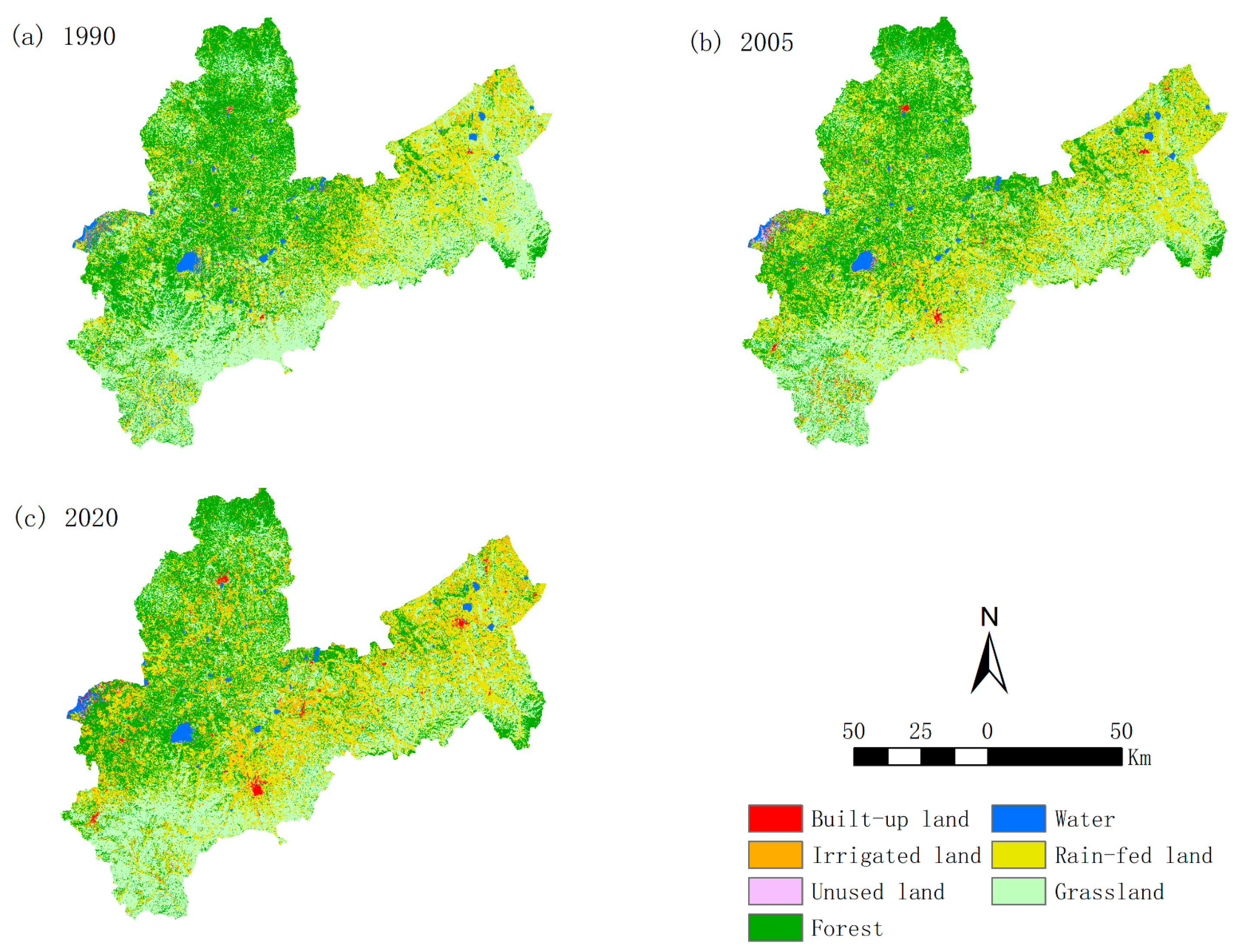
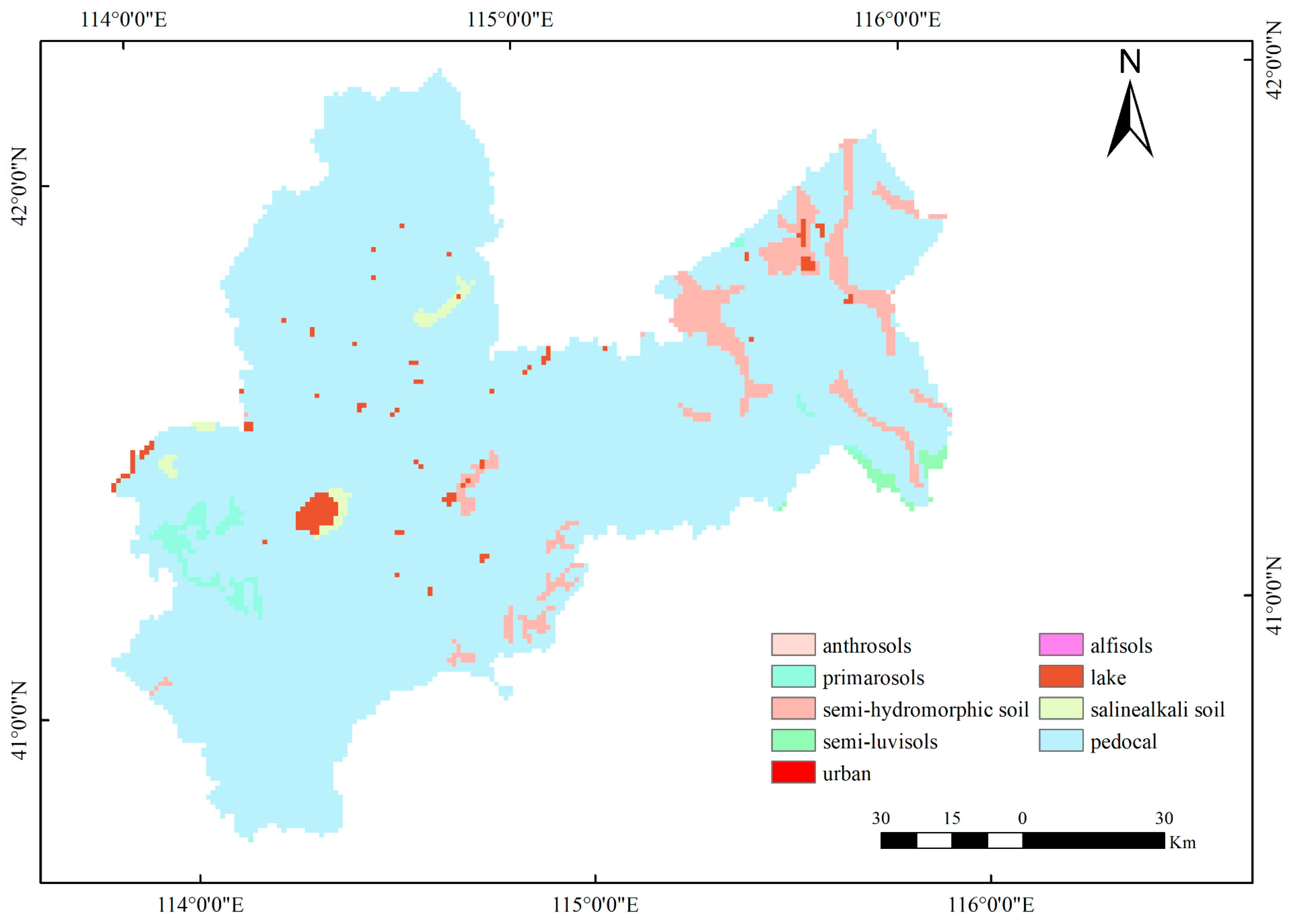


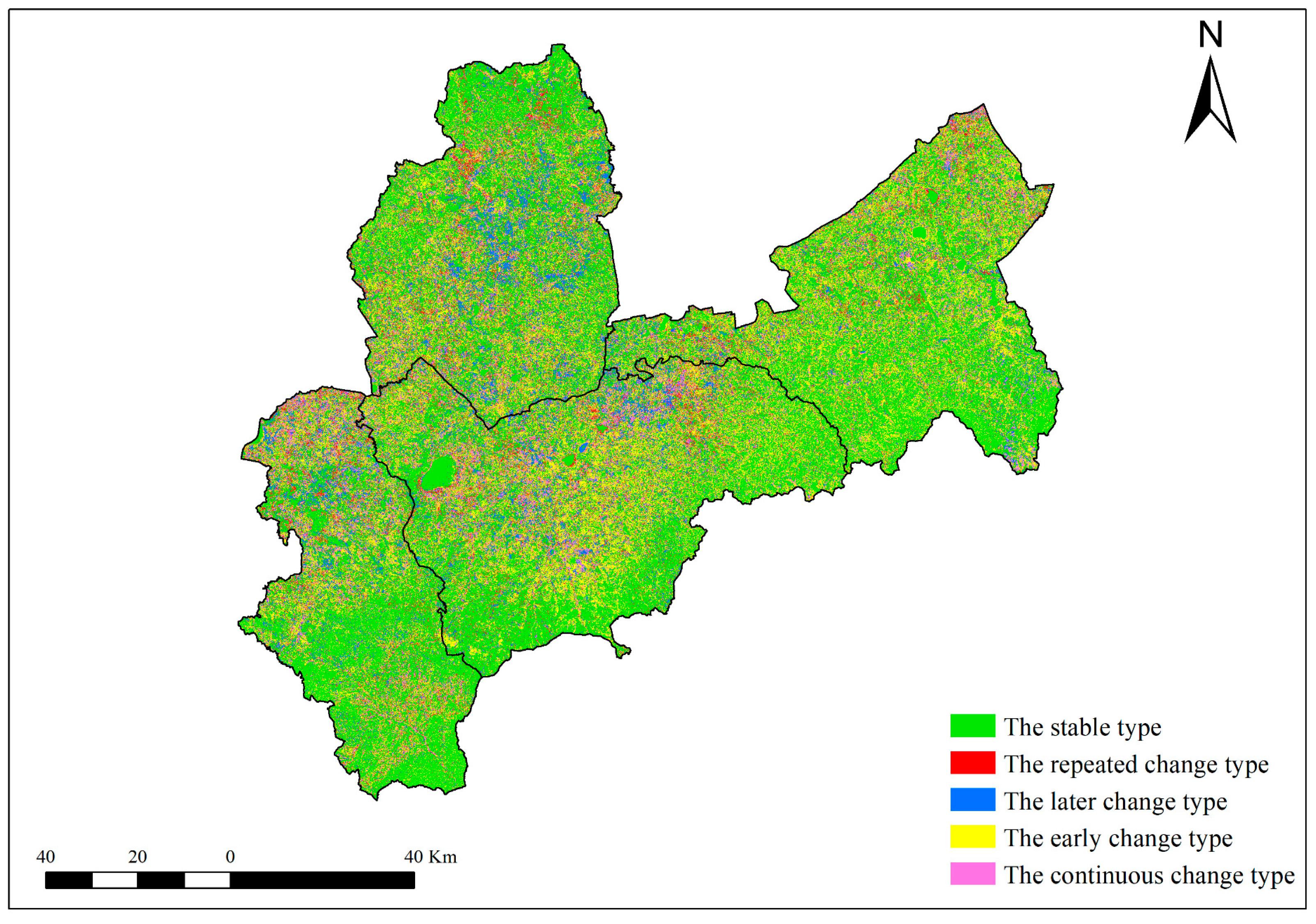
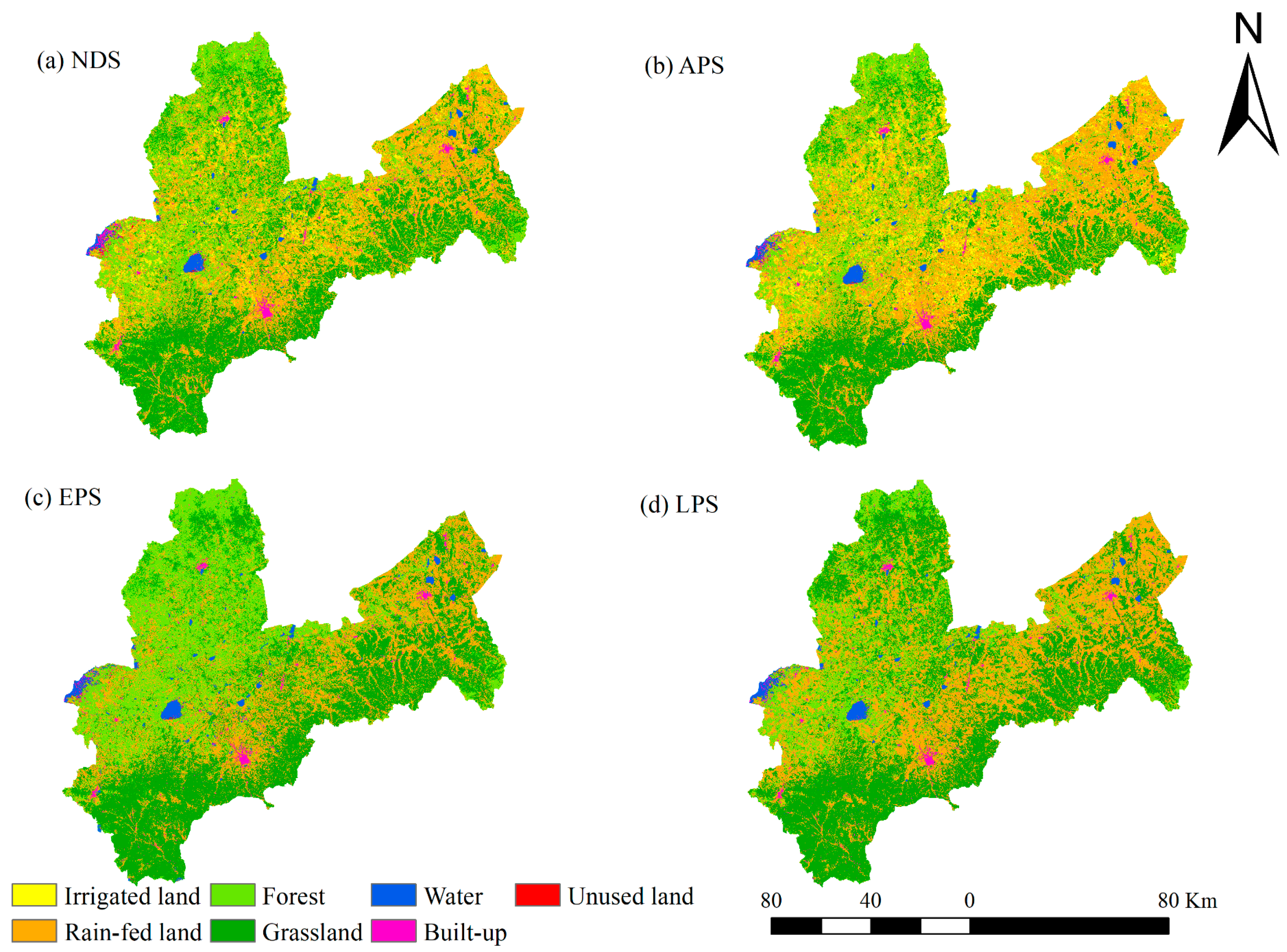

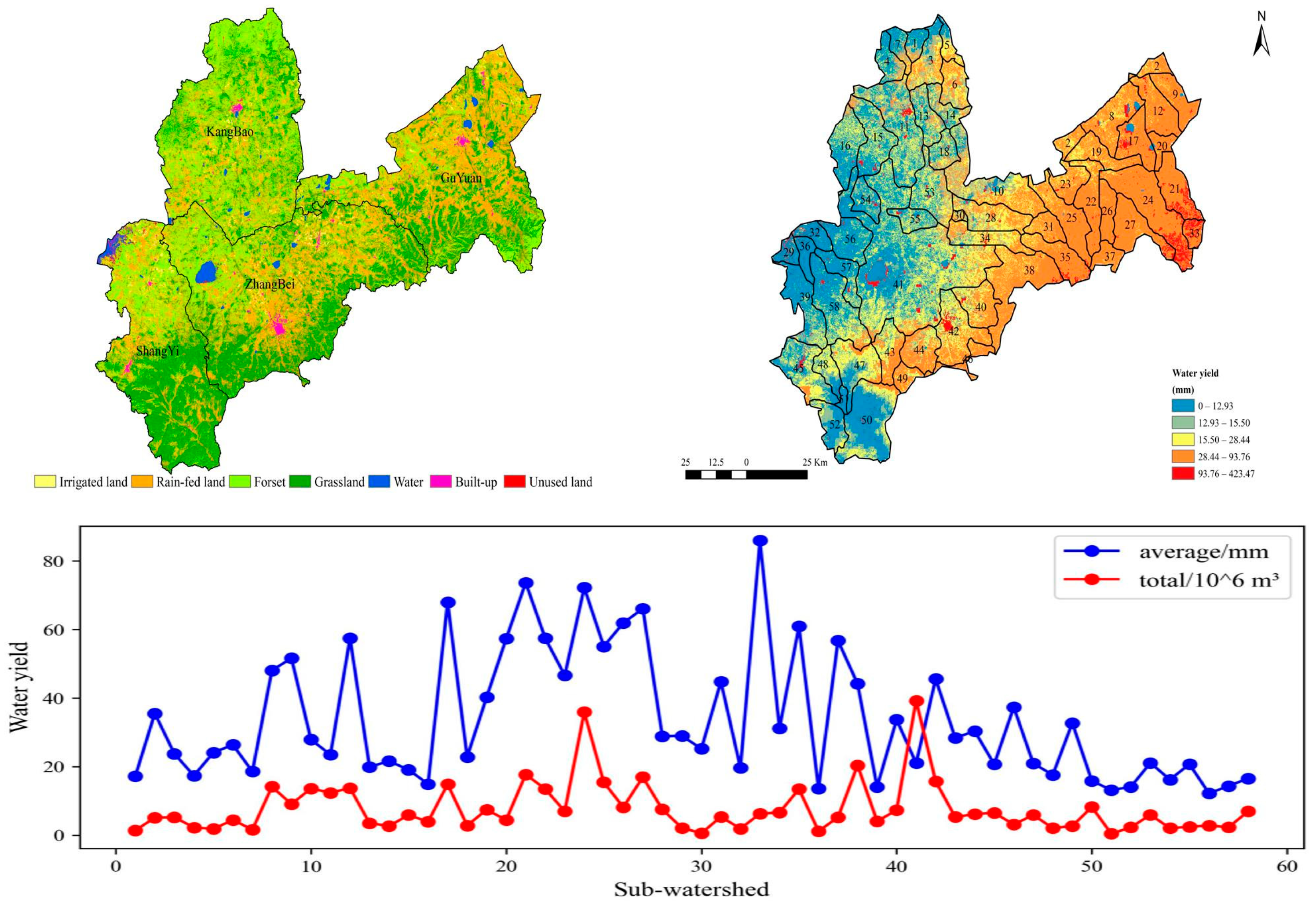


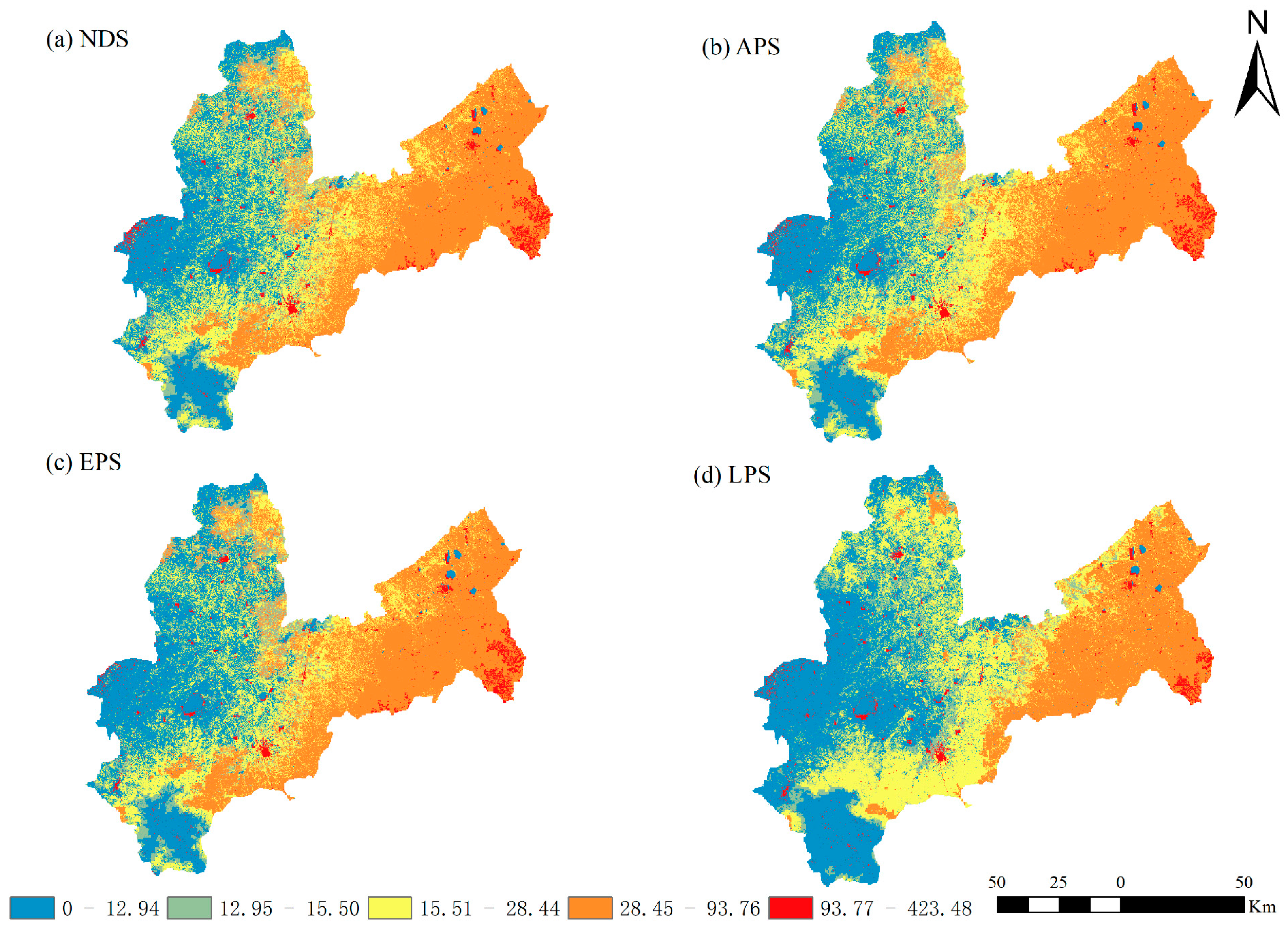

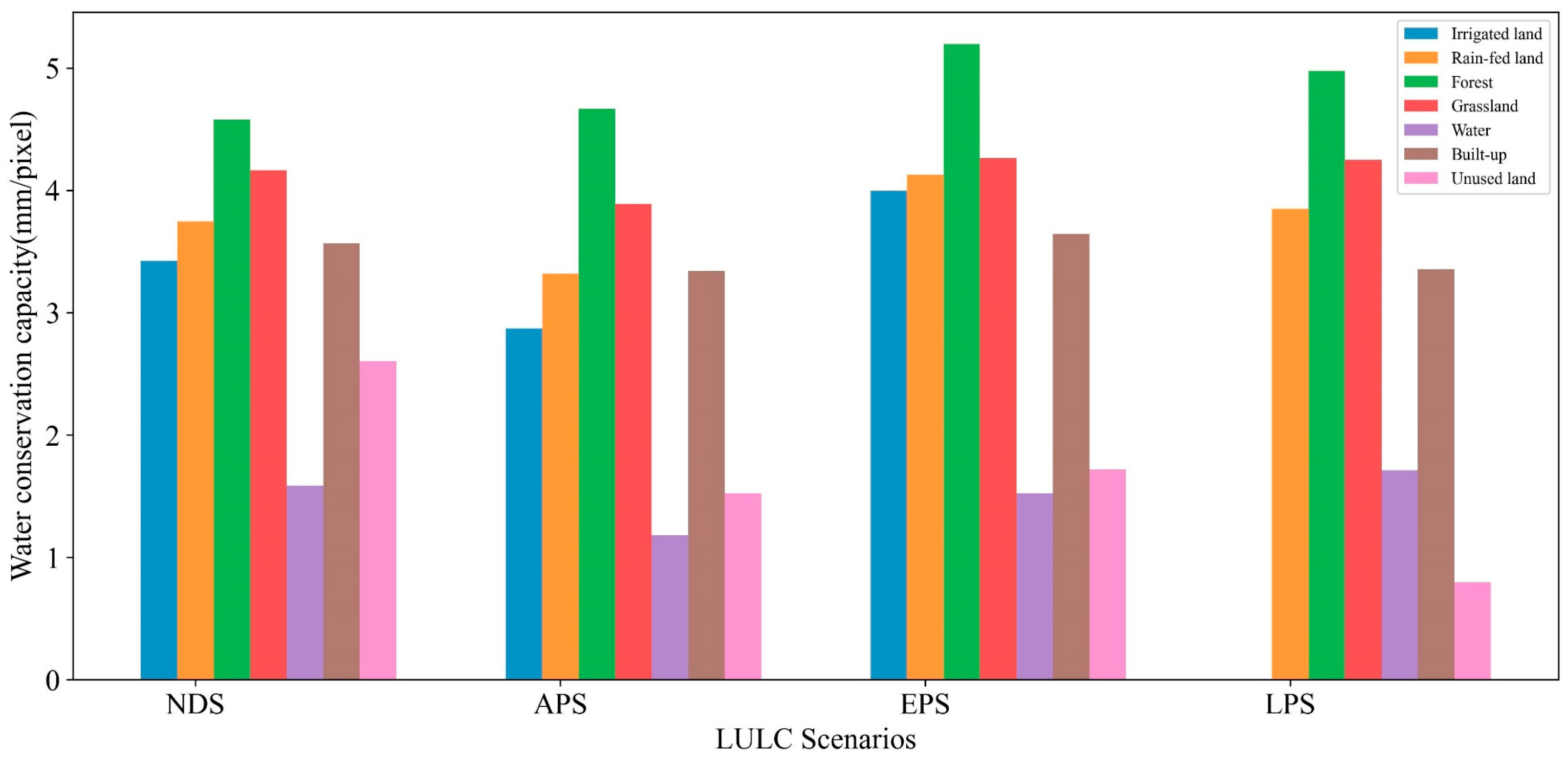
| Data Type | Data Name | Data Source |
|---|---|---|
| LULC data | LULC from 1990 to 2020 | Resources and environment science data platform https://www.resdc.cn/ |
| Natural environment | Elevation | Geospatial data cloud (https://www.gscloud.cn) |
| Slope | Extraction from elevation | |
| Aspect | ||
| Average monthly temperature | National Tibetan Plateau Data Center | |
| Average monthly precipitation | ||
| Potential evapotranspiration | ||
| Percentages of sand, clay, silt and organic carbon | Food and Agriculture Organization of the United Nations (FAO, https://www.fao.org/) | |
| Soil Type | Resources and environment science data platform (https://www.resdc.cn/) | |
| Accessibility factors | Distance from main | Geospatial data cloud (https://www.gscloud.cn) |
| road, distance from | ||
| main railway | ||
| Socio-economic | Population density, | Resources and environment science data platform (https://www.resdc.cn/) |
| gross domestic product | ||
| (GDP) |
| LULC | LULC_veg | Root_depth | Kc |
|---|---|---|---|
| Irrigated land | 1 | 300 | 0.954 |
| Rain-fed land | 1 | 300 | 0.865 |
| Forest | 1 | 3500 | 1.009 |
| Grassland | 1 | 500 | 0.8 |
| Water area | 0 | 0 | 1.05 |
| Built-up land | 0 | 1 | 0.2 |
| Unused land | 0 | 0 | 0.6 |
| Geoinformation Tupu Type | Area (km2) | Proportion | Characteristics |
|---|---|---|---|
| The stable type | 6023.9727 | 43.78% | The LULC remained unchanged from 1990–2020 |
| The continuous-change type | 1334.3436 | 9.70% | The LULC changed in 1990–2005/2005–2020 without repeated types |
| The repeated-change type | 943.029 | 6.85% | The LULC changed in the early stages as opposed to the later stages |
| The later-change type | 1628.1585 | 11.83% | The LULC changed in the period of 2005–2020 |
| The early-change type | 3828.9078 | 27.83% | The LULC changed from 1990 to 2005 but did not change from 2005 to 2020 |
| LULC | Producer’s Accuracy | User’s Accuracy | Overall Accuracy | Kappa |
|---|---|---|---|---|
| Irrgiated land | 85.69% | 86.29% | 86.93% | 0.81 |
| Rain-fed land | 85.50% | 85.38% | ||
| Forest | 84.50% | 84.60% | ||
| Grassland | 90.93% | 90.92% | ||
| Water body | 72.45% | 71.13% | ||
| Built-up | 75.75% | 75.15% | ||
| Unused land | 46.00% | 46.35% |
| Scenarios | LULC Type(km2) | ||||||
|---|---|---|---|---|---|---|---|
| Irrigated Land | Rain-Fed Land | Forest | Grassland | Water Body | Built-Up | Unused Land | |
| 2020 | 867.08 | 4035.74 | 4033.58 | 4435.96 | 165.55 | 191.45 | 31.69 |
| 2035 NDS | 1070.39 | 4087.93 | 3859.15 | 4340.97 | 147.29 | 225.95 | 29.37 |
| 2035 APS | 1653.80 | 4937.45 | 3226.86 | 3548.76 | 155.55 | 215.95 | 22.68 |
| 2035 EPS | 694.67 | 3431.97 | 4558.26 | 4651.79 | 206.69 | 203.80 | 13.87 |
| 2035 LPS | 0.00 | 4551.27 | 3157.81 | 5635.96 | 206.73 | 205.04 | 4.24 |
| 2020–2035 APS | 786.72 | 901.71 | −806.72 | −887.20 | −10.00 | 24.50 | −9.01 |
| 2020–2035 EPS | −172.41 | −603.77 | 524.68 | 215.83 | 41.14 | 12.35 | −17.82 |
| 2020–2035 NDS | 203.31 | 52.19 | −174.43 | −94.99 | −18.26 | 34.50 | −2.32 |
| 2020–2035 LPS | −867.08 | 515.53 | −875.77 | 1200.00 | 41.18 | 13.59 | −27.45 |
| 2020–2035 NDS Percentage | 23.45% | 1.29% | −4.32% | −2.14% | −11.03% | 18.02% | −7.32% |
| 2020–2035 APS Percentage | 90.73% | 22.34% | −20.00% | −20.00% | −6.04% | 12.80% | −28.43% |
| 2020–2035 EPS Percentage | −19.88% | −14.96% | 13.01% | 4.87% | 24.85% | 6.45% | −56.23% |
| 2020–2035 LPS Percentage | −100.00% | 12.77% | −21.71% | 27.00% | 24.87% | 7.10% | −86.62% |
| Scenario | Water Yield | Water Conservation Capacity | ||
|---|---|---|---|---|
| Mean (mm pixel−1) | Total (106 m3) | Mean (mm pixel−1) | Total (106 m3) | |
| 2020 | 32.720 | 446.063 | 3.820 | 27.027 |
| 2035 NDS | 33.362 | 454.808 | 3.801 | 26.556 |
| 2035 APS | 32.885 | 448.317 | 3.418 | 24.031 |
| 2035 EPS | 32.714 | 446.328 | 3.990 | 28.464 |
| 2035 LPS | 35.066 | 478.092 | 3.875 | 27.701 |
Disclaimer/Publisher’s Note: The statements, opinions and data contained in all publications are solely those of the individual author(s) and contributor(s) and not of MDPI and/or the editor(s). MDPI and/or the editor(s) disclaim responsibility for any injury to people or property resulting from any ideas, methods, instructions or products referred to in the content. |
© 2025 by the authors. Licensee MDPI, Basel, Switzerland. This article is an open access article distributed under the terms and conditions of the Creative Commons Attribution (CC BY) license (https://creativecommons.org/licenses/by/4.0/).
Share and Cite
Zhao, R.; Kan, H.; Xu, H.; Chen, C.; Zhang, G.; Pang, Z.; Zhang, W. The Effects of Multi-Scenario Land Use Change on the Water Conservation in the Agro-Pastoral Ecotone of Northern China: A Case Study of Bashang Region, Zhangjiakou City. Agriculture 2025, 15, 1008. https://doi.org/10.3390/agriculture15091008
Zhao R, Kan H, Xu H, Chen C, Zhang G, Pang Z, Zhang W. The Effects of Multi-Scenario Land Use Change on the Water Conservation in the Agro-Pastoral Ecotone of Northern China: A Case Study of Bashang Region, Zhangjiakou City. Agriculture. 2025; 15(9):1008. https://doi.org/10.3390/agriculture15091008
Chicago/Turabian StyleZhao, Ruiyang, Haiming Kan, Hengkang Xu, Chao Chen, Guofang Zhang, Zhuo Pang, and Weiwei Zhang. 2025. "The Effects of Multi-Scenario Land Use Change on the Water Conservation in the Agro-Pastoral Ecotone of Northern China: A Case Study of Bashang Region, Zhangjiakou City" Agriculture 15, no. 9: 1008. https://doi.org/10.3390/agriculture15091008
APA StyleZhao, R., Kan, H., Xu, H., Chen, C., Zhang, G., Pang, Z., & Zhang, W. (2025). The Effects of Multi-Scenario Land Use Change on the Water Conservation in the Agro-Pastoral Ecotone of Northern China: A Case Study of Bashang Region, Zhangjiakou City. Agriculture, 15(9), 1008. https://doi.org/10.3390/agriculture15091008






